|
|
Interface Processors and Port Adapters for the Cisco 7000 Family
This chapter provides information about the interface processors and port adapters common to Cisco 7000 series, Cisco 7200 series, and Cisco 7500 series routers. The information is organized into the following sections:
The Cisco 7000 series and Cisco 7500 series support any combination of Ethernet, Fast Ethernet, Token Ring, FDDI, serial, multichannel channel attachment, and HSSI interfaces. These interfaces are contained on modular interface processor boards, which provide a direct connection between Cisco's high-speed bus (or buses) and external networks. All interface processors are modular, self-contained 11 x 14-inch boards with one or more network interface connectors. All interface processors support online insertion and removal, which allows you to add, replace, or remove interface processors without interrupting the system power or entering any console commands.
Upgradeable microcode on each interface processor contains board-specific software instructions. These microcode images come bundled with Cisco IOS software, and the images load automatically when a new software image is installed. (New microcode provides additional features and enhancements to interface processors). Cisco optimizes each release of Cisco IOS software to work with the bundled microcode images.
Table 105 summarizes the interface processors described in this chapter.
Table 105 : Cisco 7000 Series and Cisco 7500 Series Interface Processors
| Interface Processor | Ports/Description |
|---|---|
| ATM | |
| CX-AIP-E3
CX-AIP-DS3 CX-AIP-TM1 CX-AIP-SM1 CX-AIP-SS1 |
1 E3 coaxial
1 DS3 coaxial 1 TAXI multimode 1 SONET multimode 1 SONET singlemode |
| Ethernet1 | |
| CX-EIP2
CX-EIP4 CX-EIP6 |
2 10-Mbps
4 10-Mbps 6 10-Mbps |
| Fast Ethernet2 | |
| CX-FEIP-1FX
CX-FEIP-2FX CX-FEIP-1TX CX-FEIP-2TX |
1 100-Mbps
2 100-Mbps 1 100-Mbps 1 100-Mbps |
| FDDI1 | |
| CX-FIP-MM3
CX-FIP-SS CX-FIP-MS CX-FIP-SM |
1 multimode to multimode
1 single-mode to single-mode 1 multimode to single-mode 1 single-mode to multimode |
| HSSI4 | |
| CX-HIP | 1 52-Mbps |
| IBM Channel | |
| CX-CIP2-PCA15
CX-CIP2-PCA25 CX-CIP2-ECA1 CX-CIP2-ECA2 CX-CIP2-ECAP15 |
Single parallel (bus and tag) second-generation channel interface
Dual parallel (bus and tag) second-generation channel interface Single ESCON second-generation channel interface Dual ESCON second-generation channel interface Single ESCON second-generation channel interface and parallel channel interface |
| MultiChannel6 | |
| CX-MIP-1CT1
CX-MIP-2CT1 CX-MIP-1CE1/75 CX-MIP-1CE1/120 CX-MIP-75/120 CX-MIP-2CE1/75 CX-MIP-2CE1/120 CX-SMIP-2CT1 CX-SMIP-2CE1/75 CX-SMIP-2CE1/120 |
1 channelized T1 or ISDN PRI
2 channelized T1 or ISDN PRI 1 channelized E1 or ISDN PRI, 75 ohm unbalanced 1 channelized E1 or ISDN PRI, 120 ohm balanced 1 channelized E1, 75 ohm unbalanced or 120 ohm balanced 2 channelized E1 or ISDN PRI, 75 ohm unbalanced 2 channelized E1 or ISDN PRI, 120 ohm balanced 2 channelized T1 or ISDN PRI 2 channelized E1 or ISDN PRI, 75 ohm unbalanced 2 channelized E1 or ISDN PRI, 120 ohm balanced |
| Serial 1, 7 | |
| CX-FSIP4
CX-FSIP8 CX-SSIP8 |
4 EIA-232, EIA-449, EIA-530, V.35, G.703/G.704
8 EIA-232, EIA-449, EIA-530, V.35, G.703/G.704 8 EIA-232, EIA-449, EIA-530, V.35, G.703/G.704 |
| Token Ring | |
| CX-TRIP2
CX-TRIP4 |
2 16-Mbps
4 16-Mbps |
| VIP28 | Using the following port adapters |
| VIP2-10(=)
VIP2-20(=) VIP2-40(=) VIP2-10/20-UPG VIP2-20/40-UPG |
PA4-E (4 Ethernet 10BaseT ports)
PA8-E (8 Ethernet 10BaseT ports) PA-FE-TX (1 100-Mbps Fast Ethernet) PA-FE-FX (1 100-Mbps Fast Ethernet) PA-4T (4 EIA-232, EIA-449, EIA-530, V.35, X.21, G.703/G.704 PA-4R (4 Token Ring) PA-5EFL (5 Ethernet 10BaseFL) PA-F-MM (1 FDDI multimode) PA-F/FD-MM (1 full-duplex FDDI multimode) PA-F-SM (1 FDDI single-mode) PA-F/FD-SM (1 full-duplex FDDI single-mode) PA-H (1 HSSI port) PA-2H (2 HSSI ports) |
Some interface processors consist of a single motherboard, while others consist of a motherboard with a companion board such as a physical layer interface module (PLIM) or a port adapter. For example, the AIP shown in Figure 17 contains a PLIM, which determines the type of ATM connection.

Interface processors such as the FSIP, FEIP, or VIP2 contain port adapters that attach to the motherboard. Figure 18 shows a VIP with two different port adapters (note that each port adapter contains a handle, which is omitted for clarity of the illustration).
Figure 18 : Port Adapters on the VIP2 (Horizontal Orientation Shown)
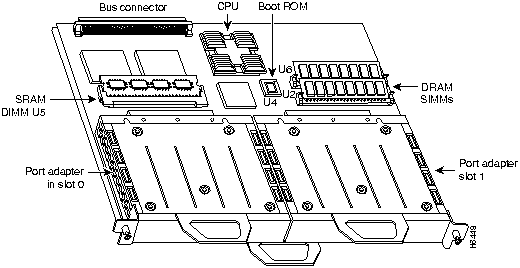
The factory installs PLIM and port adapter configurations according to the interface processor ordered.
The AIP provides a native ATM interface for the Cisco 7000. The AIP is available with one port, and it can be ordered to support one of the following media:
The ATM cable connects to a PLIM on the AIP card (see Figure 17). The module supplies the interface type and can be ordered as a spare.
The AIP is compatible with a wide range of ATM devices, for example, the LightStream 100 ATM switch, the LightStream 1010 ATM switch, the LightStream 2020 ATM switch, the Catalyst 5000 LAN switch equipped with an ATM LAN emulation module, Cisco 4000 series routers (models 4500, and 4500-M) with an ATM Network Processor module, ATM SBus adapter, and ATM switches from other vendors.
For cable and connector information about the AIP, see the section "ATM Cable Specifications" in the chapter "Cables and Transceivers."
Figure 19 : ATM Interface Processor
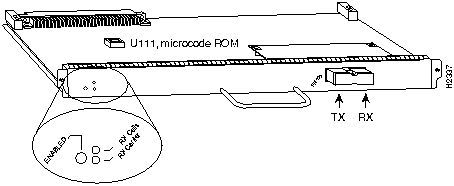
The second-generation CIP2 provides a connection to IBM or IBMcompatible mainframes. It supports both IBM mainframe cabling standards: parallel channel (also called bus and tag), and ESCON architecture. To operate with the CIP2, the Cisco 7000 series systems require Cisco IOS Release 10.2(13), or later, Release 10.3(13), or later, Release 11.0(10) or later, or Release 11.1(5) or later. The Cisco 7500 series systems require Cisco IOS Release 10.3(13), or later, Release 11.0(10), or later, or Release 11.1(5) or later. By default, the CIP2 ships with 32 MB of memory; additional memory is available in 64- and 128-MB sizes. To calculate CIP2 memory requirements, see the section "CIP2 Memory Guidelines" in the chapter "Configuration Guidelines for the Cisco 7000 Family."
Each CIP2 can support up to two IBM mainframe channel connections, which can be one of the following:
Three software features are available for the CIP2: a TCP/IP datagram feature, a TCP/IP offload feature, and an SNA support feature. TPC/IP datagram is a standard feature for the CIP2. TCP/IP offload and SNA support are licensed features and must be ordered separately.
The TCP/IP offload feature places TCP/IP protocols onto the CIP2, where they assume the responsibility of processing TCP/IP frames, calculating the checksum, and retransmitting bad frames. The mainframe TCP/IP stack is still required for the server applications (FTP, Telnet, TN3270, NFS, LPd), but TCP/IP processing is removed from the mainframe and performed on the CIP2. TCP/IP offload is supported only with IBM mainframes.
The SNA support feature delivers SNA traffic to ACF/VTAM using the External Communications Adapter (XCA) major node support provided in ACF/VTAM. CSNA on the CIP2 delivers SNA traffic to and from the mainframe from a variety of sources. Local LANs using SRB, remote LANs using RSRB or DLSw+, APPN, downstream physical unit concentration (DSPU), qualified logical link control (QLLC), source-route translational bridge (SR/TLB), and SDLLC all deliver SNA traffic to the CSNA on the CIP2. Options for the CIP2 are listed in Table 106.
| Description | Product Number |
| 32-MB memory (default CIP2 memory) | MEM-CIP-32M |
| 64-MB memory (replaces existing CIP2 memory) | MEM-CIP-64M(=) |
| 128-MB memory (replaces existing CIP2 memory) | MEM-CIP-128M(=) |
| TCP/IP offload feature for CIP2 (ordered with CIP2)1 | FR-CIP-TCPOFF |
| TCP/IP offload feature for CIP2 (spare)1 | FR-CIP-TCPOFF= |
| SNA support feature for CIP2 SNA (ordered with CIP2)1 | FR-CIP-CSNA |
| SNA support feature for CIP2 SNA (spare)1 | FR-CIP-CSNA= |
| Downstream bus and tag connection with bus and tag termination | CAB-PCA-VB |
| Upstream bus and tag connection with bus and tag termination2 | CAB-PCA-VA |
| Spare 78-pin D-shell cable for CIP2 | CAB-PCA-Y= |
| Additional ESCON channel adapter for CXCIP2PCA1 or CXCIP2ECA1 | CX-ECA1-U3 |
Figure 20 : Second-Generation Channel Interface Processor (CIP2)
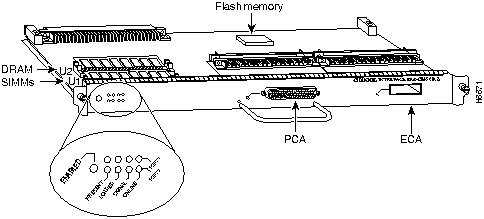
The EIP provides two, four, or six high-speed (10-Mbps) Ethernet ports. Each port requires a user-supplied 802.3 media attachment unit (MAU) and an AUI cable.
Figure 21 : Ethernet Interface Processor
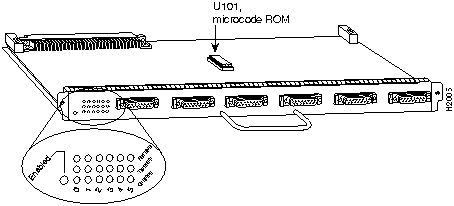
The FEIP provides one or two Fast Ethernet (100-Mbps) port(s), which support twisted pair or fiber optic cable. The 100BaseT interfaces are mounted on port adapters that attach to the FEIP motherboard. Each port adapter has two 100BaseT interfaces: one RJ-45 and one MII connection. Only one connection can be used per port adapter.
Each 100BaseT port on the FEIP has an RJ-45 connector to attach to Category 5 UTP for 100BaseTX, and an MII connector that permits, through user-provided transceivers, connection to other physical layers. Only one connector on a 1FE port adapter can be used at one time. Both full-duplex and half-duplex operations are supported.
The FEIP can operate with a variety of 100BaseFX or 100BaseTX devices, for example, the Catalyst 5000 Token Ring switch. The Cisco 7000 series router must be running either Cisco IOS Release 10.3(6) or later or Cisco IOS Release 11.0(2) or later.
Figure 22 : Fast Ethernet Interface Processor
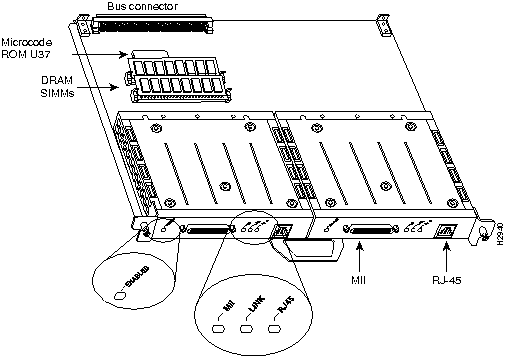
The FIP provides one high-speed (100-Mbps) FDDI port. Four types of FIPs are available:
Figure 23 : Fiber Distributed Data Interface Processor
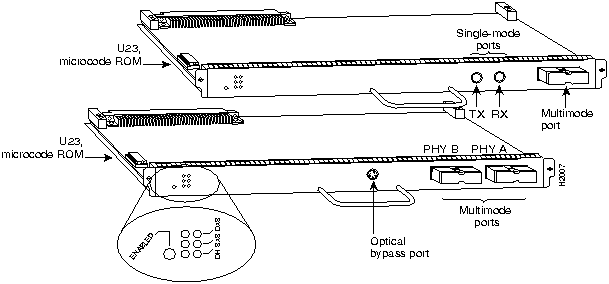
The FSIP provides four or eight high-speed serial ports (up to 8 Mbps). Each FSIP comes with a default dual-port port adapter, PA-7KF-SPA, as follows:
For G.703/G.704 support, you must order port adapters PA-7KF-E1/120= or PA-7KF-E1/75=. The G.703/G.704 cables must match the ohm rating for the port adapters. For example, PA-7KF-EI/75, the 75ohm port adapter, uses the G.703/G.704 75ohm cable, CAB-E1-BNC.
Except for G.703/G.704 port adapters, the cable connected to the port determines the interface type and mode. Table 109 lists Cisco 7000 series serial cables supported by the FSIP. These cables must be ordered with the FSIP.
Figure 24 : Fast Serial Interface Processor
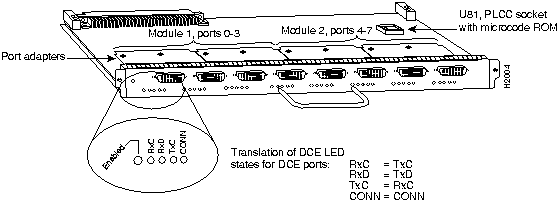
The HIP provides one HSSI (up to 52-Mbps) port. This port allows you to choose from a range of connectivity options, including ATM, SMDS, Frame Relay, or private lines---all at speeds up to DS3 or E3 (45 Mbps and 34 Mbps, respectively). Only a software configuration is necessary to accommodate these different network connections.
An HSSI cable is required for each HIP. All cables are 10 feet (3 meters) long and must be ordered with the HIP. For cable part numbers, see the section "Interface Processor Cables" at the end of this chapter.
Figure 25 : HSSI Interface Processor
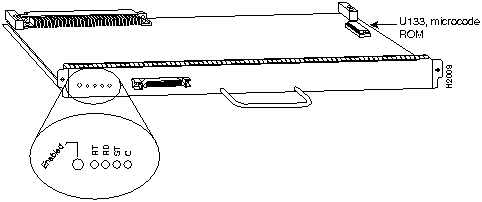
Seven models of the MIP provide a multichannel multiplexer that allows aggregate multiple channels at Nx64 and/or Nx56 on the same 1.5-Mbps T1 or 2-Mbps E1 line. Models CX-MIP-1CE1/75 and CX-MIP-2CE1/75 provide one or two E1/PRI ports 75-ohm unbalanced; models CX-MIP-1CE1/120 and CX-MIP2CE1/120 provide one or two E1/PRI 120-ohm balanced ports; model CX-MP-75/120 provides one channelized E1 75-ohm unbalanced or 120-ohm balanced port; and models CX-MIP-1CT1 and CXMIP2CT1 provide one or two T1/PRI ports. Cables must be ordered with the MIP. See Table 109 for cable product numbers.
When used with Cisco IOS dialondemand routing software, the MIP can operate as a single- or dual-port ISDN PRI device. A dual-port MIP card can be configured to allow one port to operate as an ISDN PRI while the other performs a multichannel multiplexer role.
Figure 26 : Multichannel Interface Processor

The Service Provider MultiChannel Interface Processor (SMIP) has two channelized T1 or two channelized E1 connections via serial cables to a CSU. Two controllers can each provide up to 24 T1 channel-groups or 30 E1 channel-groups. Each channel-group is presented to the system as a serial interface that can be configured individually.
Three models of the SMIP provide a multichannel multiplexer that allows aggregate multiple channels at Nx64 and/or Nx56 on the same 1.5-Mbps T1 or 2-Mbps E1 line. Model CXSMIP2CT1 provides two T1 ports, and models CX-SMIP-1CE1/120 and CXSMIP2CE1/75 provide two E1 ports with 120 ohms and 75 ohms, respectively. Cables must be ordered with the SMIP. See Table 109 for cable product numbers.
The SMIP has one or two controllers for transmitting and receiving data bidirectionally at the T1 rate of 1.544 Mbps, or at the E1 rate of 2.048 Mbps. For wide-area networking, the SMIP can function as a concentrator for a remote site.
Cisco IOS Release 10.3(6) or later supports the SMIP, which is licensed to support the following:
The SMIP does not support multiprotocol routing at data transmission rates greater than 64 kbps.
Figure 27 : Service Provider MultiChannel Interface Processor, Dual-Port Module

The Standard Serial Interface Processor (SSIP) provides eight high-speed serial ports (up to 8 Mbps).
The CX-SSIP8 comes with four dual-port port adapters (PA-7KF-SPA), which can support X.21, EIA/TIA-449, EIA/TIA-232, V.35, or EIA-530.
For G.703/G.704 support, you must order port adapters PA-7KF-E1/120= or PA-7KF-E1/75=. The G.703/G.704 cables must match the ohm rating for the port adapters. For example, PA-7KF-EI/75, the 75ohm port adapter, uses the G.703/G.704 75ohm cable, CAB-E1-BNC.
Except for G.703/G.704 port adapters, the cable connected to the port determines the interface type and mode. Table 109 lists Cisco 7000 series serial cables supported by the SSIP. These cables must be ordered with the SSIP.
Cisco IOS Release 10.3(6) or later supports the SSIP. The SSIP is licensed to support the following:
Figure 28 : Standard Serial Interface Processor
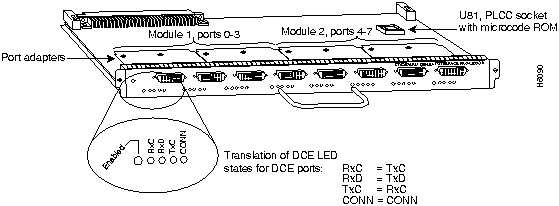
The TRIP provides two or four high-speed (4-Mbps or 16-Mbps) Token Ring ports. Each port requires a MAU to connect the DB-9 connector to the external Token Ring networks.
Figure 29 : Token Ring Interface Processor

The second-generation Versatile Interface Processor (VIP2) is a new interface processor for use with the Cisco 7000 series routers using the RSP7000, and the Cisco 7500 series routers.
The VIP2 installs in the interface processor slots in your Cisco 7000 series or Cisco 7500 series router. The VIP2 uses a single motherboard with up to two port adapters. The VIP2 port adapters provide the individual LAN, WAN, or LAN/WAN interface ports. The VIP2 can be removed from a chassis while power is on and the system is operating. There are no restrictions on the chassis interface processor slots in which the VIP2 can be installed.
The VIP2 CPU is a RISC, Mips 4700 processor that has an internal operating frequency of 100 megahertz (MHz) and a 50-MHz system bus interface. The VIP2 has 128 KB of nonvolatile random-access memory (NVRAM).
Table 107 shows the DRAM, SRAM, and software capabilities of the current VIP2 products.
| Distributed Switching (DSW) | Distributed Services (DS) | DRAM | SRAM | |
|---|---|---|---|---|
| VIP2-10 | -- | -- | 8 MB | 512 KB |
| VIP2-20 | Y | -- | 16 MB | 1 MB |
| VIP2-401 | Y | Y | 32 MB | 2 MB |
The VIP2-10 and VIP2-20 can support the following SRAM, DRAM, and software memory-configuration upgrades:
The VIP2 provides suport for any two port adapters as listed in Table 108.
Table 108 : VIP2 Port Adapters
| Description | Product Number |
|---|---|
| 4 Ethernet 10BaseT ports | PA-4E |
| 8 Ethernet 10BaseT ports | PA-8E |
| 5 Ethernet 10BaseFL ports | PA-5EFL |
| 1 Fast Ethernet 100BaseT port | PA-FE-TX
PA-FE-FX |
| 4 synchronous serial ports supporting EIA/TIA-232, EIA/TIA-449, EIA-530, X.21, and V.35 | PA-4T |
| 4 Token Ring ports | PA-4R |
| 1 FDDI multimode
1 full-duplex FDDI multimode |
PA-F-MM
PA-F/FD-MM |
| 1 FDDI single-mode
1 full-duplex FDDI single-mode |
PA-F-SM
PA-F/FD-SM |
| 1 HSSI port
2 HSSI ports |
PA-H
PA-2H |
Figure 29 shows a VIP2 board with one PA-FE-TX port adapter and a blank port adapter installed. The port adapter handles have been omitted for clarity.
Figure 30 : Second-Generation Versatile Interface Processor (VIP2)
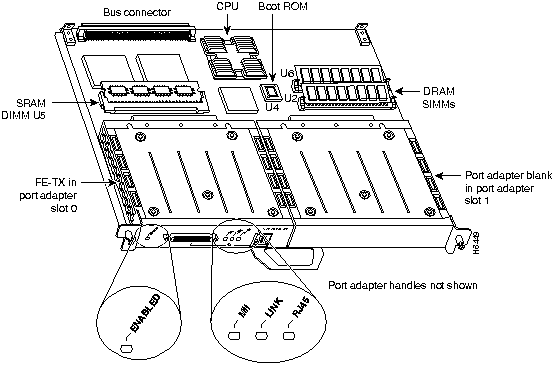
When you order a VIP2, memory and software are important considerations. Use the following information when ordering a VIP2:
The Cisco 7200 series routers and the VIP2 interface processors use port adapters to provide flexible configuration options. Table 108 lists the available port adapters.
Port adapters can be installed in an interface processor card (VIP2) or directly into an appropriate chassis (Cisco 7200 series).
Table 109 lists interface processor cables and provides ordering information. For more information about these cables, refer to the chapter "Cables and Transceivers."
Table 109 : Cisco 7000 Series and Cisco 7500 Series Interface Processor Cables
| Interface Processor | Description | Product Numbers |
|---|---|---|
| AIP | -- | For DS3/E3, use CAB-ATM-DS3/E3
Other are User supplied |
| CIP21,2 | Y cable that comes with CIP2
PCA V cable A PCA V cable B |
CAB-PCA-Y3
CAB-PCA-VA4 CAB-PC-VB |
| EIP | -- | User supplied |
| FEIP | -- | User supplied |
| FIP2 | Mini-DIN-to-DIN transition | CABFMDD= |
| FSIP2
SSIP2 VIP-4E/4T2 VIP-4R/4T2 |
X.21 high-density male DTE
X.21 high-density female DCE EIA/TIA-449 high-density male DTE EIA/TIA-449 high-density female DCE V.35 high-density male DTE V.35 high-density female DCE EIA/TIA-232 high-density male DTE EIA/TIA-232 high-density female DCE EIA-530 high-density male DTE E1-G.703/G.704 twinax 120 ohm balanced, 5 m E1-G.703/G.704 DB-15 120 ohm balanced, 5 m E1-G.703/G.704 BNC 75 ohm unbalanced, 5 m |
CAB-X21MT
CAB-X21FC CAB-449MT CAB-449FC CAB-V35MT CAB-V35FC CAB-232MT CAB-232FC CAB-530MT CAB-EI-TWINAX CAB-EI-DB15 CAB-EI-BNC |
| HIP or PA-H and PA-2H2 | Null modem, DTE, HSSI, 10'
male to male, 10' |
CAB-HNUL=
CAB-HSI1= |
| MIP or SMIP2 | DSX1 to CSU DB-15 thru
DSX1 to CSU DB-15 null E1 ISDN PRI, 10' E1 BNC 75 ohm unbalanced, 5 m E1 DB15 120 ohm balanced, 5 m E1 TWINAX 120 ohm balanced, 5 m |
CAB-7KCT1DB15
CAB-7KCT1NULL CAB-E1-PRI CAB-E1-BNC CAB-E1-DB15 CAB-E1-TWINAX |
| TRIP | -- | User supplied |
| VIP2
PA-4T |
--
X.21 high-density male DTE X.21 high-density female DCE EIA/TIA-449 high-density male DTE EIA/TIA-449 high-density female DCE V.35 high-density male DTE V.35 high-density female DCE EIA/TIA-232 high-density male DTE EIA/TIA-232 high-density female DCE EIA-530 high-density male DTE |
User supplied---except for PA-4T
CAB-X21MT CAB-X21FC CAB-449MT CAB-449FC CAB-V35MT CAB-V35FC CAB-232MT CAB-232FC CAB-530MT |
Cisco is committed to protecting your investment in its products. To achieve that, the Cisco 7500 was designed as an extension of the Cisco 7000 platform, enabling you to move existing interface processors between the Cisco 7000 and Cisco 7500 series platforms. However, to ensure forward compatibility with the Cisco 7500 series or the RSP7000 (a Cisco 7000 series router with an RSP upgrade), some interface processors may need to be modified. The Investment Protection Program (IPP) provides you with a low- or no-cost migration path for upgrading interface processors.
The IPP is intended for the following situations:
The only interface processor types that may require modification are the CX-AIP, CX-EIP, CX-FIP, and CX-FSIP. To verify if one of these processors requires modification, follow the instructions in "Verifying Interface Processor Compatibility" in the chapter "Configuration Guidelines for the Cisco 7000 Family."
Cisco provides two options for the return and upgrade process:
If you determine that your CX-AIP, CX-EIP, CX-FIP, or CX-FSIP needs to be modified, use the product numbers in Table 110 and the order form that follows.
Table 110 : Investment Protection Program Product List
| Description | Product Number |
|---|---|
| IPP Upgrade ATM Interface Processor with SONET/Multimode | CX-AIP-SM-IPP= |
| IPP Upgrade ATM Interface Processor with SONET/Single-mode | CX-AIP-SS-IPP= |
| IPP Upgrade ATM Interface Processor with TAXI/Multimode | CX-AIP-TM-IPP= |
| IPP Upgrade 2-port Ethernet Interface Processor | CX-EIP2-IPP= |
| IPP Upgrade 4-port Ethernet Interface Processor | CX-EIP4-IPP= |
| IPP Upgrade 6-port Ethernet Interface Processor | CX-EIP6-IPP= |
| IPP Upgrade FDDI Multimode Interface Processor | CX-FIP-MM-IPP= |
| IPP Upgrade FDDI Single-mode Interface Processor | CX-FIP-SS-IPP= |
| IPP Upgrade FDDI Multimode/Single-mode Interface Processor | CX-FIP-MS-IPP= |
| IPP Upgrade FDDI Single/Multimode Interface Processor | CX-FIP-SM-IPP= |
| IPP Upgrade 4-port Fast Serial Interface Processor | CX-FSIP4-IPP= |
| IPP Upgrade 8-port Fast Serial Interface Processor | CX-FSIP8-IPP= |
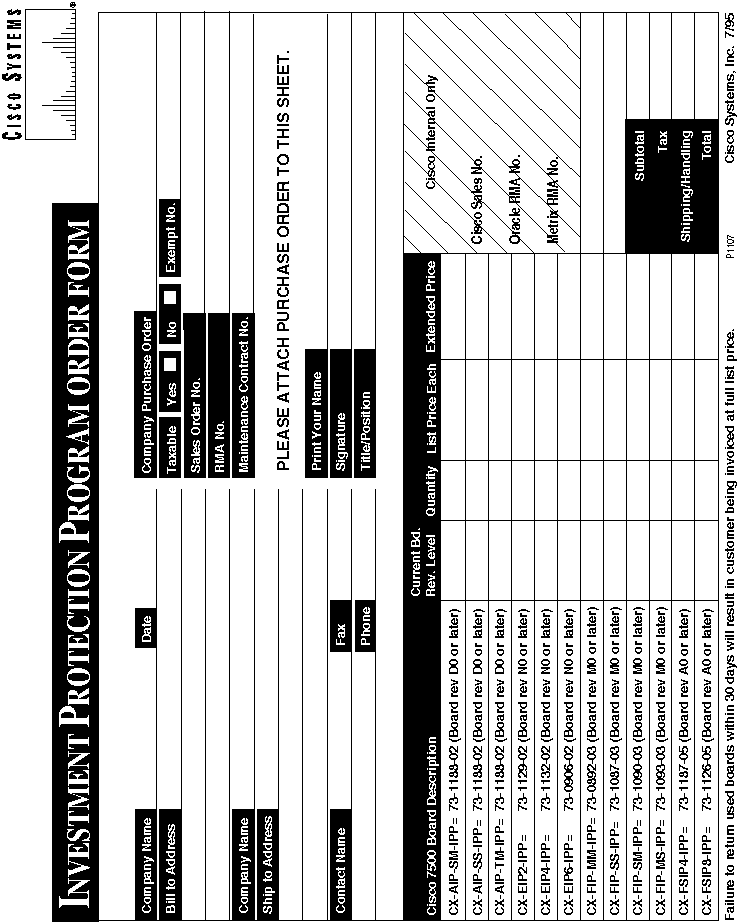
|
|
Copyright 1988-1996 © Cisco Systems Inc.